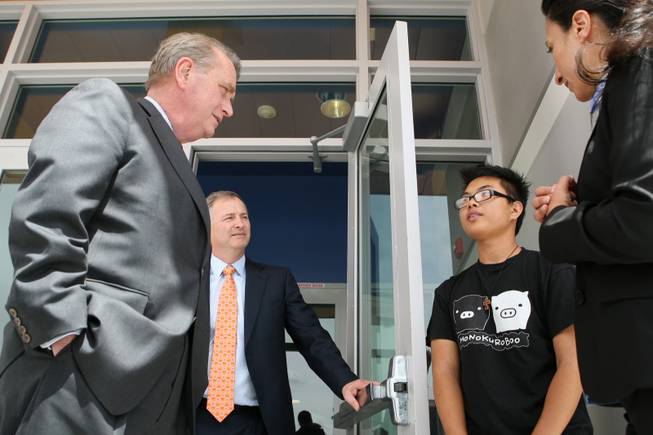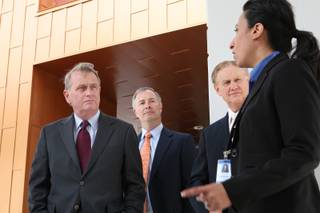
Mona Shield Payne
Las Vegas Chamber of Commerce officials Matt Crosson, left, and Steve Hill visit with sophomore Thomas Lee and Principal Felicia Nemcek at Southwest Career and Technical Academy.
Thursday, June 3, 2010 | 2 a.m.
Sun coverage
Sun archives
- Proof is in: Career-oriented education works (6-28-2008)
As the new president and CEO of the Las Vegas Chamber of Commerce, Matt Crosson has spent much of the past month getting a crash course on Southern Nevada.
And with the Clark County School District as the state’s largest employer, it makes sense that Crosson is looking closely at public education.
The relationship between the chamber and the School District has always been delicate. On initiatives that serve their mutual interests, such as bond measures to support school construction, the chamber has been a vocal cheerleader, even hosting the most recent campaign’s kickoff event. But when it comes to the biennial bloodletting known as the Nevada legislative session, the chamber is often at odds with educators. The educators push for an increase in state funding for public schools, and the chamber typically has opposed raising taxes on business and industry.
Before joining the chamber April 26, Crosson was in charge of the Long Island Association, New York’s largest business association with more than 5,000 members. While holding that post, he helped establish a nonprofit organization specifically to support public schools. He also served on several key state committees, including a panel examining school leadership and one that helped restructure New York’s educational standards.
One of his first tasks as chief of the Las Vegas Chamber is to explore better partnerships with the School District.
The chamber has indicated an intensified focus on public education with its launch of a series of reports on the subject.
In a report released in May, the chamber’s researchers concluded that at certain grade levels, socioeconomic factors were a more significant influence on student achievement than funding levels.
Does that mean schools that are reeling from steep budget cuts don’t need more money?
“To me, the real issue should be figuring out what are the most effective ways to spend the education money,” Crosson said.
“It might be a question of how the existing funding is organized and allocated.”
Last week Crosson made his first official visit to a School District campus, a 90-minute tour of the new Southwest Career and Technical Academy on West Shelbourne Avenue near Rainbow Boulevard.
“This school is an excellent investment of the community’s dollars,” he said afterward.
He also left with plenty to think about.
For starters: How can the chamber be more involved in supporting the district’s mission? How might new partnerships benefit both schools and businesses? And how can the chamber do a better job positioning itself as “pro-education”?
The district’s career and technical academies represent a logical opportunity for Crosson to start finding answers.
In traditional vocational programs, students are separated from their college-bound peers. But nationally that model has largely given way to magnet programs in which academics and training in specific fields are given equal emphasis.
The School District has invested hundreds of millions of dollars in the formula. The campuses are typically more expensive to build and operate than traditional comprehensive high schools. They require specialized equipment and “block” schedules of 85-minute instructional periods.
Five career and technical academies are spread throughout the Las Vegas Valley, with a sixth campus opening in August. And the district is seeing dividends. Dropout rates at Clark County’s career academies hover around 1 percent, compared with a districtwide average of 4.6 percent in 2009. And overall the academies’ students do well on statewide proficiency exams required for graduation.
And there’s no shortage of interest in the programs — and opportunities — they offer.
The Southwest Career and Technical Academy opened in August with just freshmen and sophomores. The junior class will begin this fall, and the academy will graduate its first class in 2012. For the 2010-11 academic year, 1,600 applications came in for 400 seats.
The campus looks more like a community college than a traditional high school. The wide hallways are lined with glass-fronted classrooms, each filled with specialized equipment for hands-on instruction.
Crosson said the campus’s layout exceeds anything he’s seen.
“It’s obvious a great deal of thought and planning went into this,” Crosson said. “I’m incredibly impressed by the quality of what’s being offered here.”
The various programs and departments divide into two key areas — the professional service academy (health sciences, automotive technology, culinary arts and hospitality and tourism) and the design academy (fashion and interior design, video game technologies and Web design, and entertainment engineering design).
One of the requirements for the district’s academies is that each campus distinguish itself with unique programs, as a means of encouraging students to apply to schools outside of their neighborhoods. One program at the Southwest Career and Technical Academy is entertainment engineering design, which prepares students to work behind the scenes in large-scale theatrical productions.
In teacher Anthony Pappano’s classroom, students are putting their training in computer-assisted design and drafting to work on behalf of the Las Vegas Zoo, which is planning a major renovation. Pappano said he has been thrilled by how engaged his students are. They’re taking their assignments far beyond what he required of them.
“It has been a revelation,” Pappano said. “The kids get so excited, and they’re always asking me to let them do more and more.”
The academy’s goal is to prepare students for the workforce and college, Principal Felicia Nemcek said. All seniors will be expected to apply to at least one postsecondary education program, whether it’s a four-year college or advanced career certification.
The district’s academies are based on the elements researchers say are essential to student success — smaller school settings, hands-on learning and rigorous academics. The academies have few student discipline problems, Nemcek said. She thinks students are more tolerant of one another than they might be at a larger comprehensive high school, and individuals who might otherwise be singled out for bullying can find safe haven.
“The kids are a little more friendly … the teachers seem more interested,” said sophomore Thomas Lee, who is studying interior design. “We get a lot of freedom.”
The academies rely heavily on the business community to help guide and shape career programs. To develop the entertainment engineering design program, the first of its kind in the district, for example, the academy’s administration is partnering with Cirque du Soleil.
The intent is to prepare students to continue studies at UNLV, which offers a degree program in entertainment engineering. Similarly, the academy is working toward an agreement with College of Southern Nevada and UNLV so that students in health sciences programs can earn some college credit.
That’s the kind of thinking the chamber needs to support, Crosson said.
“The kids are more motivated to learn because the academics are more relevant to them,” Crosson said. “This is a way to develop a pipeline of qualified young people to go into the workforce.”


Join the Discussion:
Check this out for a full explanation of our conversion to the LiveFyre commenting system and instructions on how to sign up for an account.
Full comments policy